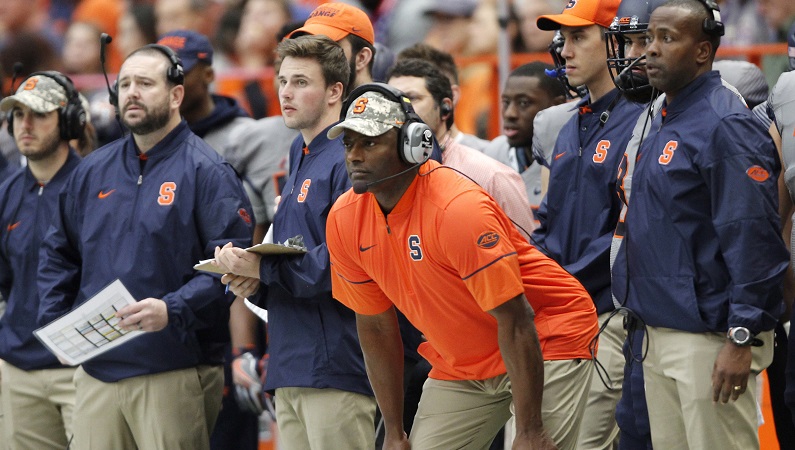Dino Babers arrived in Syracuse with a reputation as an offensive mastermind. But through the early part of the 2017 season, the Orange have been just as impressive on the defensive side of the ball.
Through three games, Syracuse ranked behind only Duke among ACC teams who had also played at least three contests in rushing yardage allowed. A favorable early slate against the likes of Central Connecticut, Middle Tennessee, and Central Michigan aided in Syracuse’s fast defensive start. But starting with Saturday night’s road game at LSU, the tests start coming hot and heavy for the Orange. The challenging midseason slate provides the Syracuse defense a chance to prove that its defensive start is not a mere mirage.
Over the next five weeks heading into its bye weekend Oct. 28, Syracuse faces off against LSU, NC State, Pitt, Clemson, and Miami. Of those five contests, only Pittsburgh presents an opportunity for the Orange to be favored. Syracuse has little chance of reaching bowl eligibility unless they can beat a couple of those teams, and will need the defense to continue overachieving.
After years of fielding confused, inexperienced defenses, this year’s Syracuse squad seems to get it. The Orange feature six seniors in the starting defensive rotation. Two of them, linebackers Zaire Franklin and Parris Bennett, recorded over a hundred tackles each in 2016. With Franklin and Bennett serving as catalysts, the Orange have been swarming and disruptive to their opponents defensively early on.
Syracuse has been particularly dominant on third down, allowing opponents to pick up just seven of 43 attempts – a conversion average of just 16.3 percent. The Orange are also forcing turnovers. They picked up three interceptions in their first three games, including a pick six, and forced eight fumbles, recovering four. Field position and punt coverage is helping, as the Orange are averaging 46 yards per punt, and a 42.8 yard net punting average.
Syracuse has not been doing as well defending the pass, allowing its first three opponents to average 219.7 passing yards against them. Part of the problem has been an overall lack of pressure on opposing quarterbacks. Through three games, Syracuse had an ACC-low two sacks.
If the Orange continue struggling to get after opposing quarterbacks once they get into the meat of the ACC Atlantic Division, this promising early-season start will dissipate. If Syracuse can’t penetrate the offensive lines of Central Connecticut, Middle Tennessee, and Central Michigan, how can they expect to apply any pressure to the likes of Kelly Bryant, Lamar Jackson, and Malik Rosier? That’s one of the biggest dilemmas that the Orange coaches have to figure out, starting with Saturday night’s showdown in Baton Rouge against LSU.

















